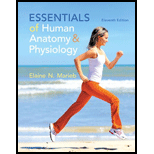
More than one choice may apply.
Which of the following is (are) a feature of lacrimai secretions?
a. Sebum d. Lysozyme
b. Mucus e. Antibodies
c. Peroxide
Introduction:
Lacrimal secretions are secreted from the lacrimal glands. The function of the lacrimal secretions is to lubricate the eyeball surface. It makes the conjunctiva and cornea moisturized. These secretions also provided the nutrients and dissolved the oxygen to the cornea.
Answer to Problem 1MC
Correct answer:
Lacrimal secretions are mucus, lysozyme, and antibodies.
Explanation of Solution
Justification/Explanation for the correct answer:
Options (b, d, e) are given that mucus, lysozyme, and antibodies. Lacrimal secretions contain lysozymes, mucus, and antibodies. Lysozyme destroys the bacteria for protecting the surface of the eye. All of these secretions together function to clean and protects the eye by moistening and lubricating the eye. Increased lacrimal secretions resultin the spilling of tears from the eyes that eventually filled the nasal cavities that causes the congestion. Hence, options (b, d, e) are correct.
Explanation for the incorrect answers:
Option (a) is given that sebum. Sebum is the oily and waxy substance that is composed of triglycerides, wax esters, and metabolites of fat-producing cells. It is not included in the lacrimal secretions. So, it is an incorrect option.
Option (c) is given that peroxide. Peroxide is not produced by the lacrimal glands in the form of lacrimal secretions. So, it is an incorrect option.
Hence, options (a) and (c) are incorrect.
Therefore, it can be concluded as lacrimal secretions are mucus, lysozyme, and antibodies that moisten and lubricate the eyeball.
Want to see more full solutions like this?
Chapter 8 Solutions
Essentials of Human Anatomy & Physiology Plus MasteringA&P with eText -- Access Card Package (11th Edition)
- Plekhg5 functions in bottle cell formation, and Shroom3 functions in neural plate closure, yet the phenotype of injecting mRNA of each into the animal pole of a fertilized egg is very similar. What is the phenotype, and why is the phenotype so similar? Is the phenotype going to be that there is a disruption of the formation of the neural tube for both of these because bottle cell formation is necessary for the neural plate to fold in forming the neural tube and Shroom3 is further needed to close the neural plate? So since both Plekhg5 and Shroom3 are used in forming the neural tube, injecting the mRNA will just lead to neural tube deformity?arrow_forwardWhat are some medical issues or health trends that may have a direct link to the idea of keeping fat out of diets?arrow_forwardwhat did charles darwin do in sciencearrow_forward
- fa How many different gametes, f₂ phenotypes and f₂ genotypes can potentially be produced from individuals of the following genotypes? 1) AaBb i) AaBB 11) AABSC- AA Bb Cc Dd EE Cal bsm nortubaarrow_forwardC MasteringHealth MasteringNu × session.healthandnutrition-mastering.pearson.com/myct/itemView?assignment ProblemID=17396416&attemptNo=1&offset=prevarrow_forward10. Your instructor will give you 2 amino acids during the activity session (video 2-7. A. First color all the polar and non-polar covalent bonds in the R groups of your 2 amino acids using the same colors as in #7. Do not color the bonds in the backbone of each amino acid. B. Next, color where all the hydrogen bonds, hydrophobic interactions and ionic bonds could occur in the R group of each amino acid. Use the same colors as in #7. Do not color the bonds in the backbone of each amino acid. C. Position the two amino acids on the page below in an orientation where the two R groups could bond together. Once you are satisfied, staple or tape the amino acids in place and label the bond that you formed between the two R groups. - Polar covalent Bond - Red - Non polar Covalent boND- yellow - Ionic BonD - PINK Hydrogen Bonn - Purple Hydrophobic interaction-green O=C-N H I. H HO H =O CH2 C-C-N HICK H HO H CH2 OH H₂N C = Oarrow_forwardFind the dental formula and enter it in the following format: I3/3 C1/1 P4/4 M2/3 = 42 (this is not the correct number, just the correct format) Please be aware: the upper jaw is intact (all teeth are present). The bottom jaw/mandible is not intact. The front teeth should include 6 total rectangular teeth (3 on each side) and 2 total large triangular teeth (1 on each side).arrow_forward12. Calculate the area of a circle which has a radius of 1200 μm. Give your answer in mm² in scientific notation with the correct number of significant figures.arrow_forwardDescribe the image quality of the B.megaterium at 1000X before adding oil? What does adding oil do to the quality of the image?arrow_forwardarrow_back_iosSEE MORE QUESTIONSarrow_forward_ios
 Medical Terminology for Health Professions, Spira...Health & NutritionISBN:9781305634350Author:Ann Ehrlich, Carol L. Schroeder, Laura Ehrlich, Katrina A. SchroederPublisher:Cengage Learning
Medical Terminology for Health Professions, Spira...Health & NutritionISBN:9781305634350Author:Ann Ehrlich, Carol L. Schroeder, Laura Ehrlich, Katrina A. SchroederPublisher:Cengage Learning
 Human Biology (MindTap Course List)BiologyISBN:9781305112100Author:Cecie Starr, Beverly McMillanPublisher:Cengage Learning
Human Biology (MindTap Course List)BiologyISBN:9781305112100Author:Cecie Starr, Beverly McMillanPublisher:Cengage Learning- Essentials of Pharmacology for Health ProfessionsNursingISBN:9781305441620Author:WOODROWPublisher:Cengage
 Human Heredity: Principles and Issues (MindTap Co...BiologyISBN:9781305251052Author:Michael CummingsPublisher:Cengage Learning
Human Heredity: Principles and Issues (MindTap Co...BiologyISBN:9781305251052Author:Michael CummingsPublisher:Cengage Learning





